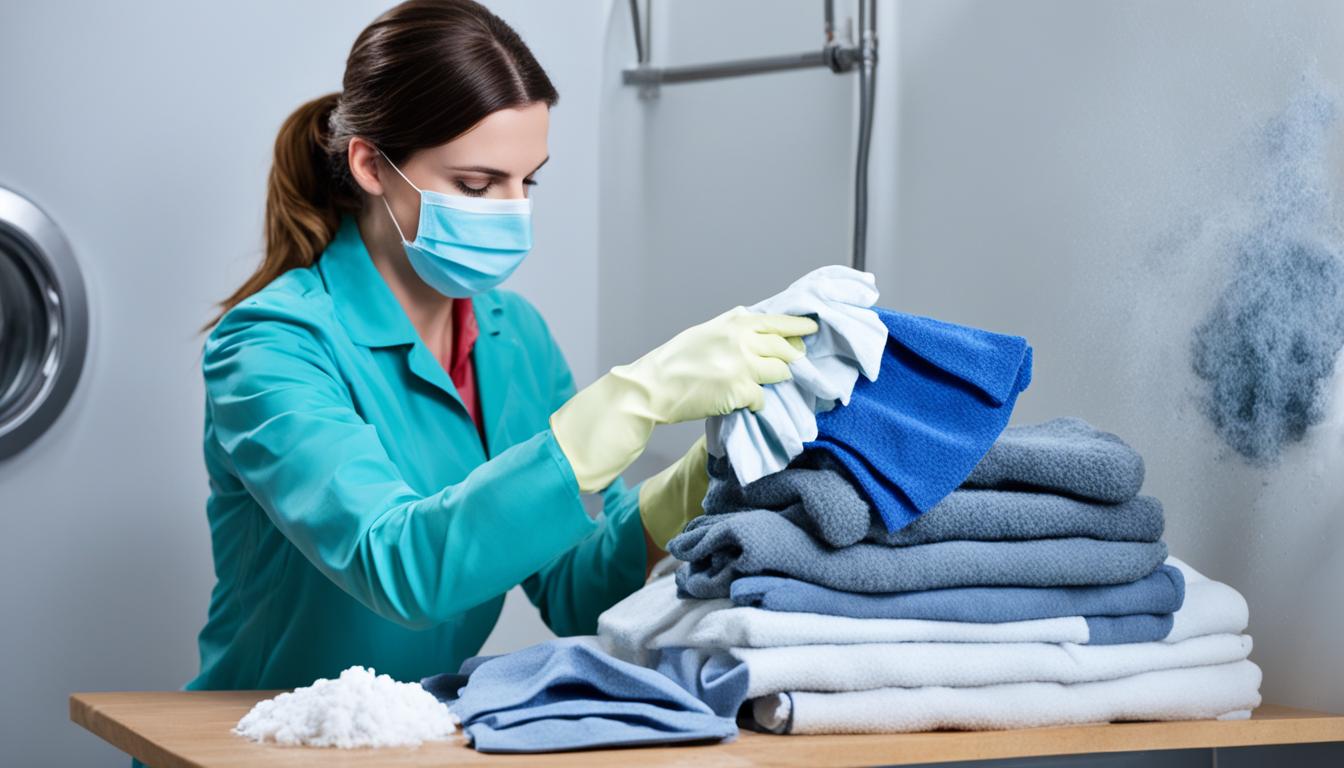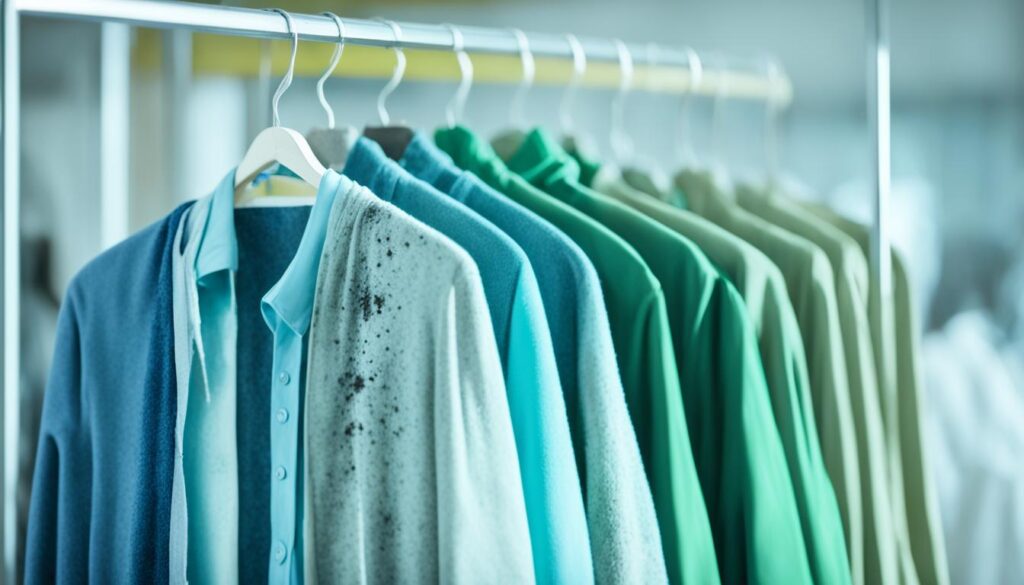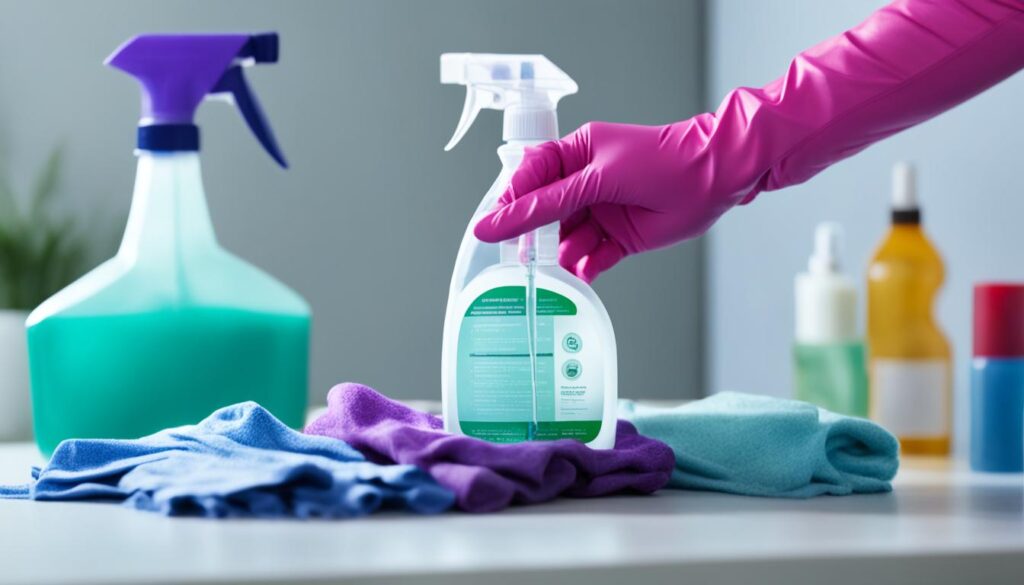
Reviving Your Wardrobe: Fix Moldy Clothes Now
Are you wondering, “Can you fix moldy clothes?” Don’t worry, we’ve got you covered. Dealing with moldy clothes can be a nightmare, but with the right techniques, you can revive your wardrobe and ensure your garments are mold-free.
Mold removal from clothes can be a tricky process, as it requires careful cleaning and repairing of moldy garments. However, with expert tips and effective methods, you can successfully tackle this issue and save your beloved outfits.
Key Takeaways:
- It is possible to fix moldy clothes with the right techniques.
- Mold removal from clothes requires careful cleaning and repairing.
- Expert tips and methods can help you effectively tackle moldy garments.
- Reviving your wardrobe and ensuring mold-free clothes is achievable.
- Take prompt action to address mold issues and prevent further damage.
Understanding Mold Remediation for Clothes
In this section, we will delve into the process of mold remediation for clothes. Whether you’ve discovered mold on your favorite clothing items or want to be prepared for future incidents, it’s essential to understand how to treat mold on clothing, removing mold stains, and effectively eliminate mold from your garments. By following the best practices outlined below, you’ll be able to restore your clothing to a clean and mold-free state.
How to Treat Mold on Clothing
Mold on clothing can be treated using various methods depending on the severity of the mold and the fabric type. For light surface mold, you can start by gently brushing off the mold spores using a soft-bristle brush or cloth. Shake off any loose mold outdoors to prevent further contamination.
| Fabric Type | Treatment Method |
|---|---|
| Cotton, Linen, and Synthetic Blends | Machine wash at the highest water temperature recommended for the fabric. |
| Delicate Fabrics (Silk, Wool, Cashmere) | Consult a professional dry cleaner for specialized mold removal services. |
| Leather and Suede | Use a cloth dampened with a mild soap solution to gently clean the affected areas. Avoid soaking the material as it may cause damage. |
Removing Mold Stains from Clothes
In some cases, mold may leave behind stubborn stains on clothing even after the mold spores are eliminated. To remove mold stains, follow these steps:
- Pre-treat the stained area by applying a mixture of equal parts white vinegar and water.
- Gently scrub the stain using a soft brush or cloth.
- Rinse the garment thoroughly with clean water.
- Wash the garment as per the fabric’s care instructions.
Effective Mold Remediation for Clothes
To ensure effective mold remediation for clothes, it’s crucial to address the root cause of mold growth and prevent future outbreaks. Here are some essential steps to consider:
- Identify and fix any moisture issues in your storage area or wardrobe to prevent mold growth.
- Store clothing in a clean, dry, and well-ventilated space to discourage mold formation.
- Regularly inspect your clothing for signs of mold, especially if you live in a humid environment.
- Consider using moisture-absorbing products such as silica gel or moisture absorber bags in storage areas.
Remember, proper mold remediation for clothes is essential to protect your health and extend the lifespan of your garments. By taking the necessary steps to treat mold on clothing, remove mold stains, and prevent future mold growth, you can enjoy a clean and mold-free wardrobe.

Continue to section 3 to discover professional tips for fixing moldy clothes and restoring your cherished garments.
Professional Tips for Fixing Moldy Clothes
When it comes to restoring moldy clothing, it’s essential to employ professional tips and strategies for optimal results. From preventive measures to effective cleaning methods, here are expert insights to help you fix moldy clothes and restore them to their former glory.
1. Act Quickly to Prevent Further Damage
If you discover mold on your clothes, the key is to act quickly. Mold can spread rapidly and cause irreversible damage to your garments. Start by isolating the affected items and ensuring they are kept away from other clothing to prevent contamination.
2. Identify the Type of Fabric
Not all fabrics are created equal. Different materials require specific cleaning methods to avoid damage. Before attempting any restoration, identify the type of fabric in order to choose the appropriate approach. Refer to the clothing labels or seek professional advice if unsure.
3. Use a Mold Cleaner or DIY Solution
There are various mold cleaners available in the market specifically formulated for clothes. Follow the instructions provided by the manufacturer for safe and effective use. Alternatively, you can create a DIY solution using a mixture of vinegar and water or hydrogen peroxide. Test a small, inconspicuous area of the garment before applying the solution to the entire affected area.
4. Gently Remove Mold Stains
When dealing with mold stains, it’s crucial to approach the removal process with care. Use a soft brush or cloth to gently scrub the affected area, applying the mold cleaner or DIY solution. Avoid aggressive scrubbing as it can damage the fabric fibers.
5. Sunlight as a Natural Mold Killer
If weather permits, harness the power of sunlight as a natural mold killer. Hang your moldy clothes outside on a sunny day to take advantage of the sun’s UV rays. The sunlight can help kill the remaining mold spores and freshen up your garments.
Remember to check the clothing periodically and remove them from direct sunlight once they are sufficiently dry to prevent any potential discoloration.
“Act quickly when dealing with moldy clothes to prevent further damage. Identify the fabric type, use mold cleaners or DIY solutions, gently remove stains, and harness sunlight as a natural mold killer.”
6. Consult a Professional
In some cases, mold damage may be extensive, or delicate fabrics may require specialized care. If you’re unsure or uncomfortable with the restoration process, it’s always wise to consult a professional mold remediation service. They have the knowledge, expertise, and tools to ensure your clothes are safely and effectively restored.
By following these professional tips, you can confidently tackle moldy clothes and successfully restore them. Remember, prevention is key, so be proactive in safeguarding your wardrobe against mold growth.

| Pros of DIY Mold Removal | Cons of DIY Mold Removal |
|---|---|
| Economical | Risk of incomplete removal |
| Convenient | Potential damage to delicate fabrics |
| Immediate action | Possibility of spreading mold spores |
| Control over cleaning methods | Requires time and effort |
Conclusion
In conclusion, moldy clothes can be effectively restored using the right techniques and proper mold remediation methods. By following the expert tips and insights shared in this article, you can revive your wardrobe and ensure your clothes are mold-free. It is essential to prioritize mold prevention and promptly address any mold issues to maintain the longevity and quality of your garments.
Remember to regularly inspect your clothing for signs of mold and take immediate action to prevent further spread. When treating moldy clothes, it is crucial to choose the appropriate cleaning method based on the fabric type and severity of the mold contamination. A gentle yet effective approach can help you safely remove mold stains and eradicate any lingering spores.
Additionally, consider implementing preventive measures such as proper ventilation, moisture control, and storage practices to minimize the risk of mold growth on your clothes. By maintaining a clean and dry environment and storing your garments in breathable materials, you can mitigate the chances of encountering mold-related issues in the future.
With the right knowledge and proactive measures, you can preserve your clothing collection and prevent mold from wreaking havoc on your favorite pieces. Don’t let moldy clothes ruin your style and confidence. Take control of the situation, apply the recommended techniques, and enjoy a fresh and mold-free wardrobe for years to come.




